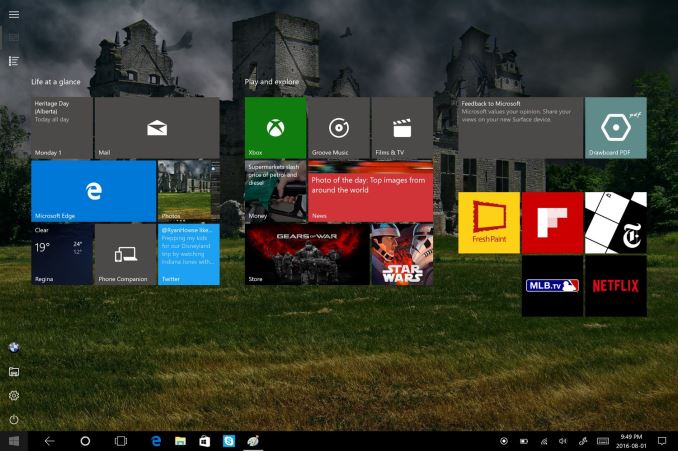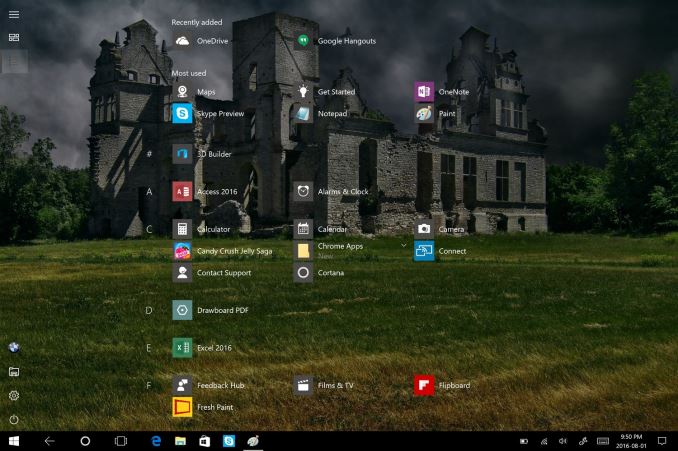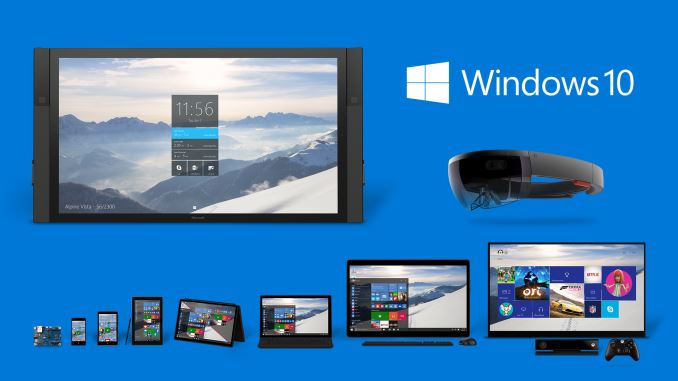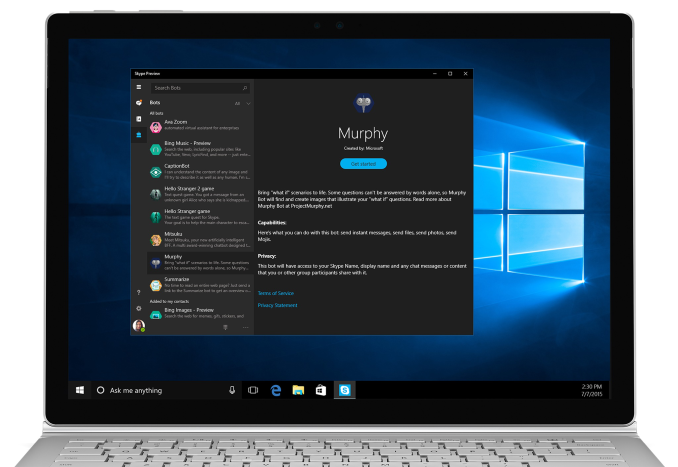Windows 10 Anniversary Update: The Road To Redstone
by Brett Howse on August 2, 2016 8:00 AM EST- Posted in
- Operating Systems
- Microsoft
- Windows 10
Tablet Mode changes, Windows Everywhere, and Skype
Tablet Mode
When Windows 10 launched, Tablet Mode, aka Continuum, was the new solution to offer Windows 10 across both traditional desktop computers, as well as touch first, or touch only devices like tablets. Overall, the interface worked well enough, but it was a step back from the usability of Windows 8.1 as a tablet interface. Still, the balance of desktop versus tablet was improved greatly with Windows 10, so it was a net win. With the Anniversary Update, Microsoft is bringing some of the Windows 8.1 features back to improve Tablet Mode.
The first change is the Start Screen layout. It’s still the same basic design, but the left hand side has been adjusted to make it more usable. The hamburger menu stays at the top, but directly under it is now the All Apps button. Toggling this switches from the Start Screen to All Apps much more akin to how it was in Windows 8.1, with a full screen scrollable list, rather than just a list on the left side. It makes it a lot easier to scroll more apps quicker, and see everything you have installed. Also, the left side contains icons for File Explorer, Settings, Power, and logout. It’s a subtle change, but it really is a lot more usable now.
Another thing that was missing was the full-screen tablet experience: in Windows 8.1, full-screen apps would lose the taskbar at the bottom. When Windows 10 shipped, the taskbar would stay planted at the bottom. There’s now an option to auto-hide the taskbar to make it a more immersive feel. I personally really liked the taskbar, since it makes it much easier to switch apps, but it’s nice to have the option back for those that prefer it.
The browser is a big part of tablets, and this has already been mentioned, but the addition of swipe navigation in Edge helps a lot as well.
Tablet Mode has improved a lot since the initial release, and these changes, added to previous changes such as the ability to toggle on “more tiles” makes the latest update much better to use. It’s likely still not quite as good as Windows 8.1 was, but the net gain with the much better desktop is still a better overall solution.
Windows Everywhere
It’s been Microsoft’s goal for a long time to bring Windows 10 to all devices, and that was a tall hill to climb. But, it has happened, and users of Windows can now experience the benefits of the work to get here. Windows 10 Mobile is not a different operating system, but the same Windows 10 base with a different UI to make it work better on the small touch screen. With Microsoft’s failure to establish a foothold in the mobile market, it’s almost too little, too late, but regardless, fixes and changes they make to Windows 10 also find their way to the phone. This is as simple as the new mail app, updated to support multiple sending accounts, instantly worked on the phone too since it’s a Universal Windows App. What’s more, Windows has been expanded to work on devices as small as IoT, to Hololens, to the ultra-large screen of the Surface Hub.
This work has also expanded to the Xbox One, and with the Summer Update for Xbox rolling out on July 29th, the fruits of this labor has already been seen. The latest Xbox update offers much of the same interfaces as Windows 10, including slide-out menus with a hamburger button, as well as the ability to (finally) run Universal Windows Apps. The Movies and TV app on the Xbox is the exact same one as on the PC, which is the exact same one as on the phone. Updates to the UWP will fix issues on all three.
It’s been a long road, and the casualty of the march to where Microsoft made it is the loss of the mobile market. They’ve transitioned there to providing apps and services, but Windows 10 Mobile is now pretty good at a time where it’s unlikely most people will ever use it.
Skype
And how can we forget Skype? Skype’s had a long and arduous road to where it is now, but it seems like it’s finally become a focus of the company. With the Anniversary Update, we see our first look at the new UWP version of Skype, replacing the old WinRT version, and likely eventually the Win32 version as well. It’s been out in preview for a while, and overall it’s been pretty solid.
It offers a dark mode, much like many of the Microsoft UWP apps, and the same UWP exists on Windows 10 Mobile as well. Likely the biggest feature is one that hasn’t made it to Skype yet. Microsoft has promised to add SMS support within Skype, so you can use Skype as a portal for both Skype messages and SMS. It’s something that they already had in Windows 10 Mobile when it first shipped, but it was later removed, and then a new Messaging app was tested, which was also killed off. The final solution is to use the Skype UWP to allow you to send SMS messages from your PC, and assuming it’s not too far out, that’s a decent solution considering how much better the Skype UWP has been.














194 Comments
View All Comments
jlabelle2 - Wednesday, August 17, 2016 - link
- 1. Major - It enables Windows DefenderYeah. Remove any 3rd party anti-virus you have. It makes no sense. Slow down things for no benefit.
mgraymond - Wednesday, August 3, 2016 - link
Where did you get the Ruined Castle wallpaper?Zingam - Wednesday, August 3, 2016 - link
So will Windows 10 Upgrade install on my laptop or I will have a huge problem just like with the Upgrade from Windows 8 to 10? Yes, after the upgrade Windows 10 works fine but the Upgrade would lock and I don't remember anymore what I had to do to make it complete. But I wasted several days and many failed attempts to install it.K_Space - Wednesday, August 3, 2016 - link
I can't seem to be able to install Edge extensions without being logged on Store. I am assuming there is no work around that one? meh, back to Firefox.mkozakewich - Wednesday, August 3, 2016 - link
Q: "Why didn't the pickle wear his shirt?"A: "Because he was brining sexy back!"
K_Space - Thursday, August 4, 2016 - link
Ouch! Local backup was installed on a BitLocked HDD. Now it shows as unformatted. Anyone got a similar issue?boeush - Thursday, August 4, 2016 - link
Meh... I have 2 new Win 10 Pro laptops from very different vendors (Sager and HP.) And after update, both still wake from sleep with fingerprint reader not working. Prior to update, one had periodic crashes of the 'explorer' process leading to corruption of desktop; restarting the process would fix it - haven't yet seen that issue since update, there hasn't been much time yet and I'm not holding my breath.Microsoft continues its long-established pattern to ship half-baked, unfinished, buggy, poorly tested software and systems, so that I feel like I'm constantly running on beta software at best (and early alpha at worst.)
Murloc - Thursday, August 4, 2016 - link
consumer laptops are better left with the OS they shipped with really, support by vendors just sucks.MrTuKer - Wednesday, August 10, 2016 - link
Or alternatively installing an efficient non-spying OS like Linux Ubuntu !Linux works fine on my Laptops, mind you they both are i7's with 980m GPU's and have 512GB SSD's and 16GB and 32GB of ram.
They were both Win 7 64 Pro Laptops thats why they have so much ram whereas Linux only really needs 8GB !
milkod2001 - Thursday, August 4, 2016 - link
Since im on W10 im experiencing weird blue screens. It only happens on desktop start up. It always shows random issue. It will switch off computer then. After i switch on computer back again it will boot system and then it is 100% stable. Anybody experiencing the same?